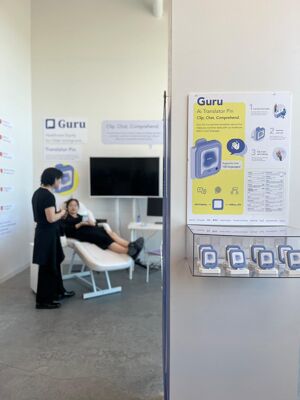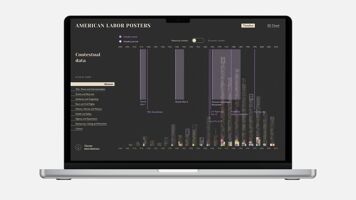ReHubA platform for monitoring digital therapeutic exercise
plans
Context

When
July 2018 - Present
Where
Work projects @ DyCare (Barcelona, Spain)
Who
Design team of 2, supervised by Ricardo Jauregui
(CTO), with occasional collaborations with design
firm. Final product delivered by DyCare dev.
Why
The current model for rehabilitation services is not
scalable: our aging population will demand them more as
time goes on, but supply will be affected by a shortage
of qualified professionals. DyCare, the startup I used
to work for, aims to be part of the solution with a
telerehabilitation platform that allows physiotherapists
to design and monitor tailored exercise programs for
patients, who use motion-tracking technology to follow
the program at home. Here you will find three samples of
my work at DyCare.
Sample 1: Patient Progress section
Before this feature, patient adherence with ReHub
exercise programs fell at approximately 2 weeks in.
Interviews with patients and physiotherapistts revealed
the app suffered from a lack of positive
reinforcement.
The Progress section was conceived as a gamification tool to engage patients and prevent them from abandoning their therapy program. It included a progress graph where patients can track the exercises they have done and need to do and a trophy system that unlocks trophies after the patient meets certain criteria.Design Iterations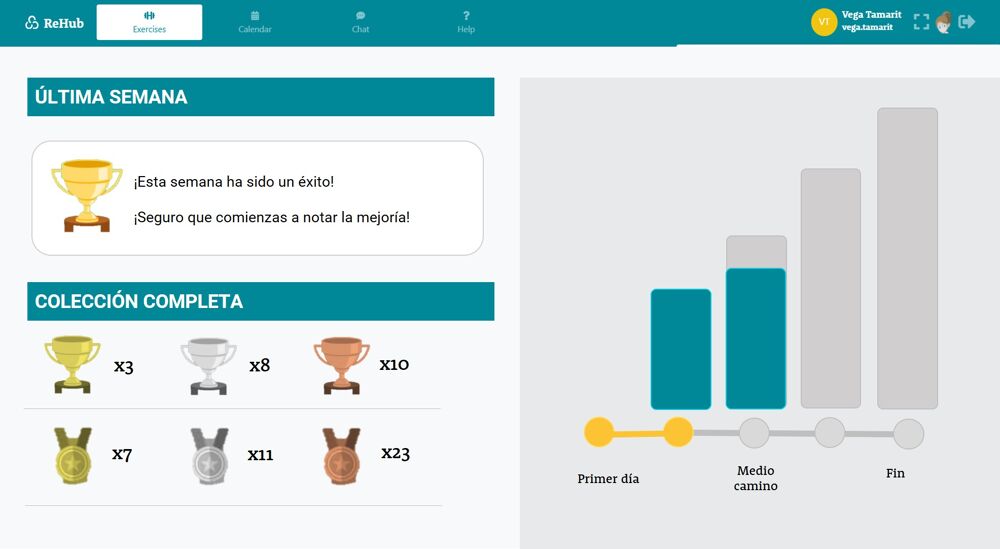
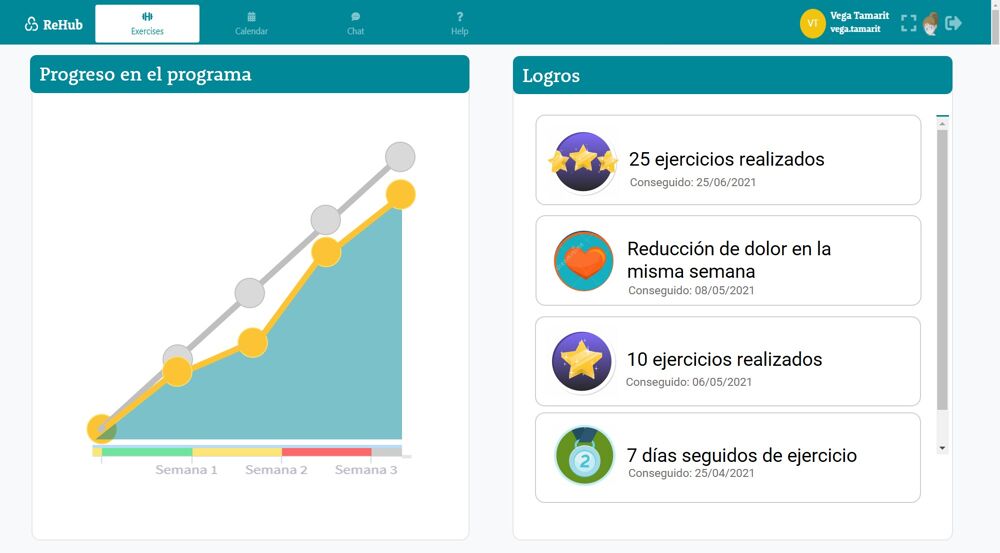 First, we thought about how the interface would roughly
look: we would need a progress chart and a visualization of
the trophies worked until that moment. Then, we brainstormed
which kind of trophies would work well in this context. The
original trophy system was going to be more ambitious, but
conversations with patients indicated that a more simple
system would be more clear, given their age. After release
and collecting user feedback, the feature was being reworked
to include more indicators like the evolution of pain
level.Final Interface The final trophies were obtained from open source
libraries. After release and collecting user feedback, the
feature is being reworked to include more indicators like
the evolution of pain levels.
First, we thought about how the interface would roughly
look: we would need a progress chart and a visualization of
the trophies worked until that moment. Then, we brainstormed
which kind of trophies would work well in this context. The
original trophy system was going to be more ambitious, but
conversations with patients indicated that a more simple
system would be more clear, given their age. After release
and collecting user feedback, the feature was being reworked
to include more indicators like the evolution of pain
level.Final Interface The final trophies were obtained from open source
libraries. After release and collecting user feedback, the
feature is being reworked to include more indicators like
the evolution of pain levels.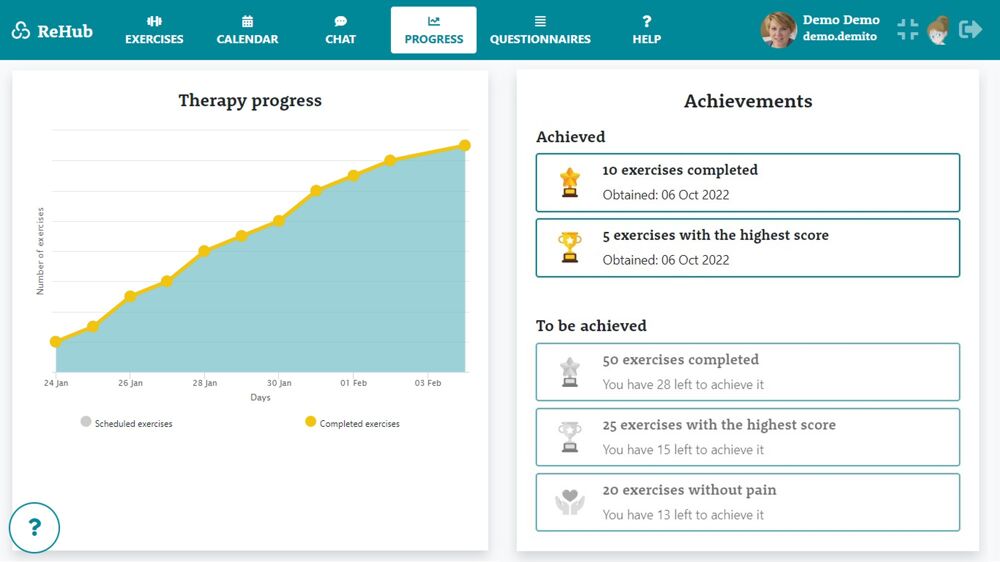
The Progress section was conceived as a gamification tool to engage patients and prevent them from abandoning their therapy program. It included a progress graph where patients can track the exercises they have done and need to do and a trophy system that unlocks trophies after the patient meets certain criteria.Design Iterations

 First, we thought about how the interface would roughly
look: we would need a progress chart and a visualization of
the trophies worked until that moment. Then, we brainstormed
which kind of trophies would work well in this context. The
original trophy system was going to be more ambitious, but
conversations with patients indicated that a more simple
system would be more clear, given their age. After release
and collecting user feedback, the feature was being reworked
to include more indicators like the evolution of pain
level.Final Interface The final trophies were obtained from open source
libraries. After release and collecting user feedback, the
feature is being reworked to include more indicators like
the evolution of pain levels.
First, we thought about how the interface would roughly
look: we would need a progress chart and a visualization of
the trophies worked until that moment. Then, we brainstormed
which kind of trophies would work well in this context. The
original trophy system was going to be more ambitious, but
conversations with patients indicated that a more simple
system would be more clear, given their age. After release
and collecting user feedback, the feature was being reworked
to include more indicators like the evolution of pain
level.Final Interface The final trophies were obtained from open source
libraries. After release and collecting user feedback, the
feature is being reworked to include more indicators like
the evolution of pain levels.
Sample 2: Exercise Library
The exercise library, where each exercise is a different
"card", was used on a daily basis by physiotherapists to
design therapeutic exercise programs. The card design was
optimized to display as many exercises as possible, but
the actual visualization of the exercise was poor.
Moreover, the exercise filters hid upon scrolling and
slowed the exercise selection process.
I thought a playing card-like design would fix this. We sent a sample to the design firm Eunoia and commissioned them this work to optimize for time.
Conversations with the design firm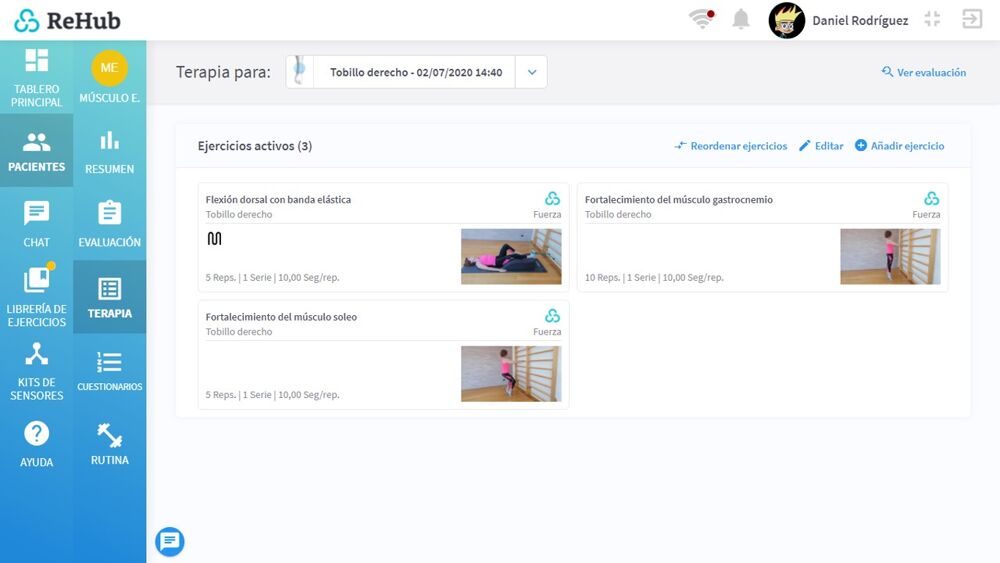 Original design
Original design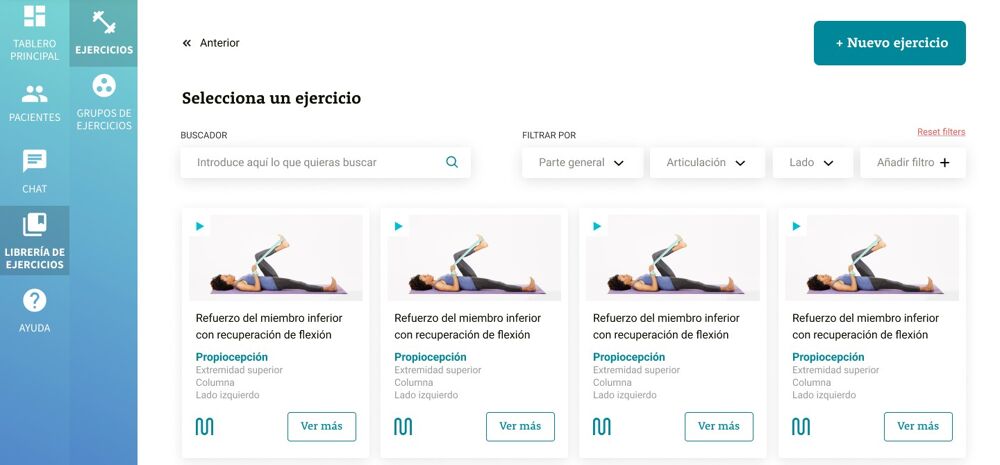 Eunoia's design
I made the following suggestions after the design firm
cleaned the card design and the filters and sent a mockup
back to Eunoia:
Eunoia's design
I made the following suggestions after the design firm
cleaned the card design and the filters and sent a mockup
back to Eunoia:
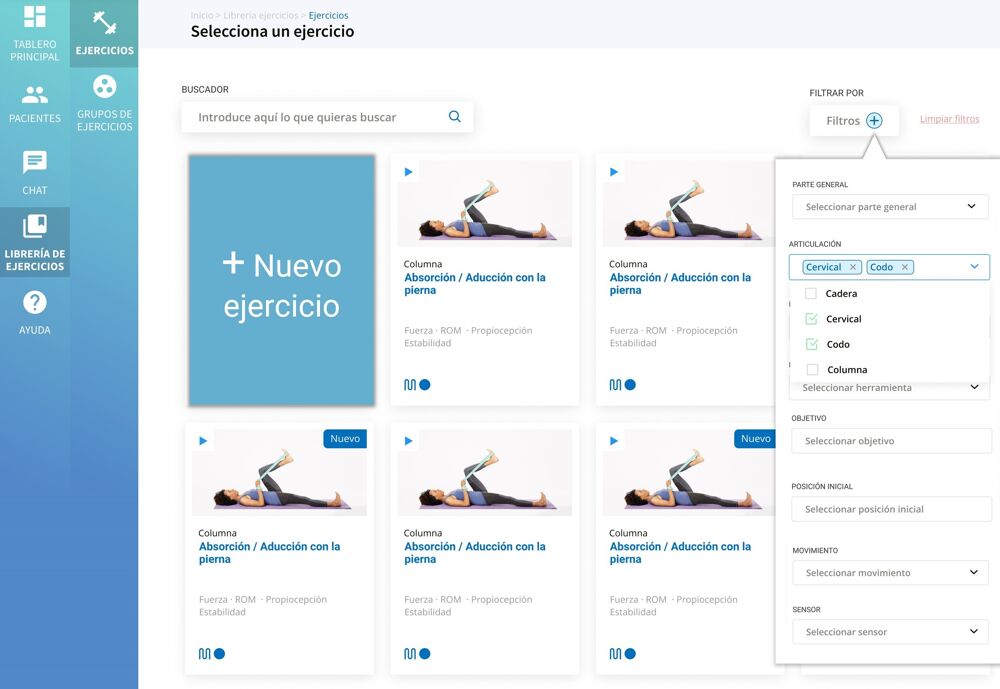 Mockup of my recommendationsFinal Interface In the final design, the New exercise button is more
subdued but still very visible, and the filters are pinned
on the right by default. As a result, searching for specific
exercises became 50% faster.
Mockup of my recommendationsFinal Interface In the final design, the New exercise button is more
subdued but still very visible, and the filters are pinned
on the right by default. As a result, searching for specific
exercises became 50% faster.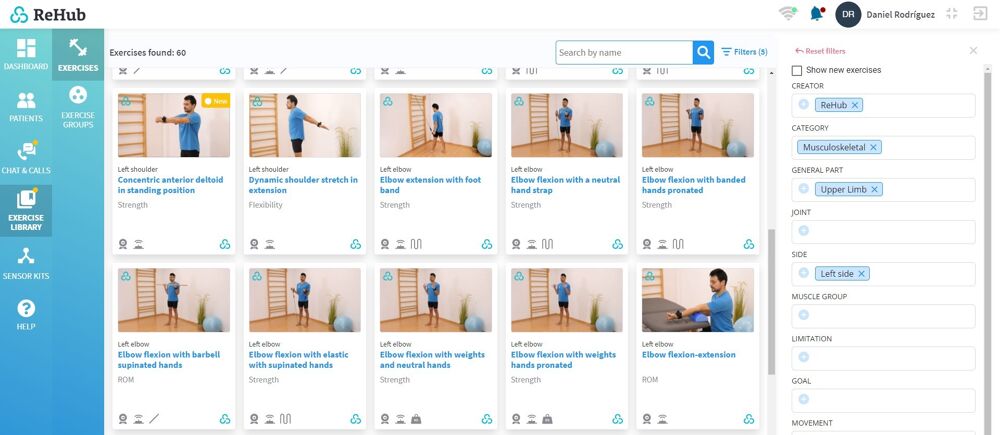
I thought a playing card-like design would fix this. We sent a sample to the design firm Eunoia and commissioned them this work to optimize for time.
Conversations with the design firm
 Original design
Original design Eunoia's design
I made the following suggestions after the design firm
cleaned the card design and the filters and sent a mockup
back to Eunoia:
Eunoia's design
I made the following suggestions after the design firm
cleaned the card design and the filters and sent a mockup
back to Eunoia:- A redistribution of the text styles inside the card, as it was giving too much importance to the exercise's category.
- Moving the filters to the right side, based on other successful products like Airbnb or Skyscanner,
- Making the Create New Exercise button more prominent, given its importance in the user workflow.
- Including GIFs of each exercise to our backlog (moved to backlog due to technical difficulties in the implementation).
 Mockup of my recommendationsFinal Interface In the final design, the New exercise button is more
subdued but still very visible, and the filters are pinned
on the right by default. As a result, searching for specific
exercises became 50% faster.
Mockup of my recommendationsFinal Interface In the final design, the New exercise button is more
subdued but still very visible, and the filters are pinned
on the right by default. As a result, searching for specific
exercises became 50% faster.
Sample 3: Speech Therapy module
ReHub was solely used for musculoskeletal injuries until
2022. An analysis of the operations of hospitals using the
platform revealed an opportunity for expanding the
platform to speech therapy patients. I led the development
of a Minimum Viable Product
for the remote treatment of dysphagia (difficulty of swallowing), which involved interviews
with users, reconfiguring interfaces and testing them with
patients. This new module could represent a 10% revenue increase in future contracts with hospitals.
I acted as the Project Lead, coordinating communication with the hospitals, working along 2 software developers and validating The CTO assisted in interviews with hospital staff.
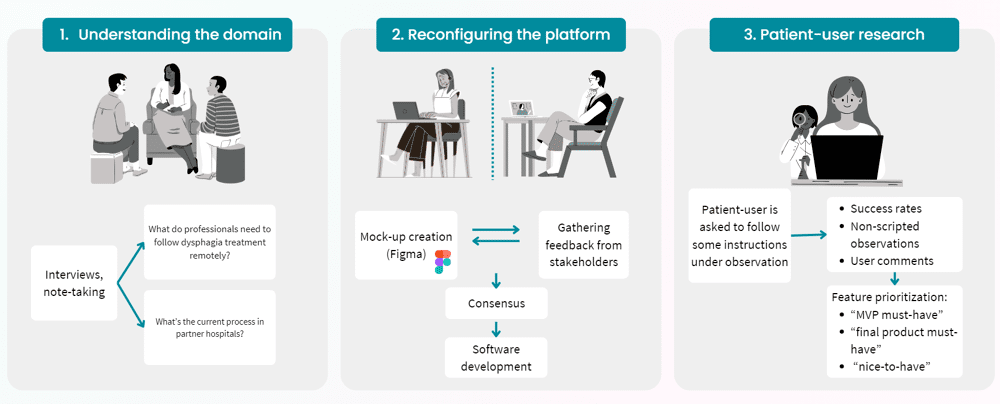
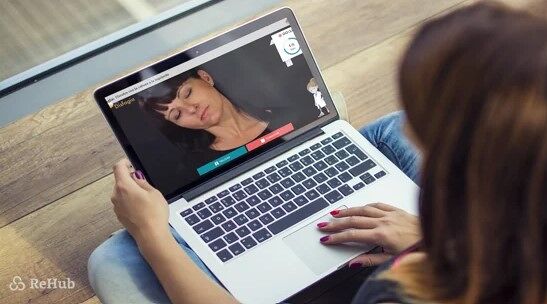
I acted as the Project Lead, coordinating communication with the hospitals, working along 2 software developers and validating The CTO assisted in interviews with hospital staff.


 Back to Top
Back to Top
